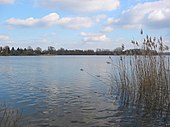Ludwigsluster Chaussee (Schwerin)
The Ludwig Chaussee is a 8500 meter long thoroughfare in Schwerin , neighborhoods Feldstadt , Ostorf , Big Dreesch / Garden City and Göhrener firs . It is the longest street in Schwerin and leads in a north-south direction from Ostorfer Ufer / Platz der Jugend / Graf-Schack-Allee in the center of Schwerin to over Karl-Marx-Allee as Bundesstrasse 321 to Landstrasse 72 and parallel to the federal motorway 14 then to the federal highway 24 to Ludwigslust .
Back streets
The secondary and connecting roads have been designated as Ostorfer shore after Ostorfer Lake , Graf-Schack-Allee after the poet, jurist and diplomat Adolf Friedrich von Schack (1815-1894), place of youth, Luther street after the reformer (1483-1546 ), Slüterufer after the Mecklenburg reformer Joachim Slüter (1490–1532), Lischstraße after the prehistorian Georg Christian Friedrich Lisch (1801–1883), Krösnitz, Osterberg, Hagenower Straße after the nearby town, Lennéstraße after the garden artist Peter Joseph Lenné (1789– 1866), Am Püsserkrug after the traditional restaurant (1746/48 to 1979) in the Gartenstadt, An der Crivitzer Chaussee after the nearby town, Brink after the geographical term for a slightly elevated place, Blumenbrink, Langer Berg, Rudolph-Karstadt- Strasse after the department store entrepreneur (1856–1944) who also worked in Schwerin, Karl-Marx- Allee (B 321) after the philosopher, economist and protagonist of the labor movement (1818–1883), Graf-Yorck- Strasse after the Generalfe Idmarschall (1759–1830), unnamed road, unnamed forest path and ferry route.
history
Surname
The street was named after the royal seat of Ludwigslust, which was the seat of the dukes and grand dukes of Mecklenburg-Schwerin from 1756 to 1837 . The Baroque Ludwigslust Castle, Schlossstrasse and other buildings bear witness to the past of the city, which today has just over 12,000 inhabitants.
development

A medieval path through the woods connected Schwerin with the settlements and villages to the south such as Lübesse , Fahrbinde , Dreenkrögen, Wöbbelin , Gut Klenow and Klenow , which was renamed Ludwigslust in 1754. While the dukes had moved their residence to Ludwigslust from 1763 to 1837, the connection between the two places often had to be used because the government authorities remained in Schwerin.
For the developing industrial area in Schwerin-Süd, apartments had to be built from 1971 onwards, among other things in the Großer Dreesch (a hallway name ). Ludwigsluster Chaussee was expanded to four lanes between today's federal highway 321 and the city center, and bridge structures were built at the triangle to An der Crivitzer Chaussee and Johannes-Stelling-Straße . At the same time, the tram network was expanded from 1974. The so-called stadium bridge over the Chaussee built in 1974 and made of prestressed reinforced concrete showed cracks due to corrosion on the prestressing steel in the 2010s and had to be blown up and demolished in November 2014; a new building is not planned.
In terms of traffic , the street is partially developed by tram lines 1, 2, 3 and 4 of Nahverkehr Schwerin GmbH (NVS) to Karl-Marx-Straße. Bus lines 9 and 16 cross the street at Klein Buchholz / NVS depot.
Buildings, plants (selection)
There are mostly two- to eleven-story buildings on the street.
- Ostorfer See ; around 200 hectares in size, 3 to 5 meters deep
- Lazy Lake ; around 50 hectares in size, 6 to 11 meters deep
- Gutenbergstrasse No. 1: 7-gesch. Administration building from 1975 with 2-storey. Newer (around 1996) semicircular extension for the Schwerin newspaper publisher with the Schweriner Volkszeitung (SVZ) from 1946
- West side: concrete sculpture Welcome to Schwerin from 1977
- West side, Blumenbrink No. 64: shopping center
- East side: 5-stor. and 11-gesch. Prefabricated houses from the Großer Dreesch
- West side of Rudolph-Karstadt-Strasse: 5-storey. Prefabricated house as a long frame construction of a former barracks
- No. 53: Central Recycling Center Schwerin
- No. 72: SAS Recycling Center Schwerin
- East side / Graf-Yorck-Straße 1: Bauhaus Großer Dreesch
- East side / Graf-Yorck-Straße 21: Main fire and rescue station of the Schwerin fire brigade
- Forest areas on both sides
- West side: forest cemetery
- West side / Stern Buchholz 25: VIVIMEI Hundehotel Schwerin
literature
- Wilhelm Jesse : History of the city of Schwerin. From the first beginnings to the present . Bärensprung'sche Hofbuchdruckerei, Schwerin 1913/1920; Reprints of the two editions as volume 1 and volume 2, Verlag Stock und Stein, Schwerin 1995, ISBN 3-910179-38-X .
- Bernd Kasten and Jens-Uwe Rost: Schwerin. History of the city . Thomas Helms Verlag, Schwerin 2005, ISBN 3-935749-38-4 .
- Dieter Greve: Schwerin street names. Their origin and meaning . Ed .: State capital Schwerin, land registry and surveying office, Schwerin 2014, ISBN 3-9805165-5-5 .
Web links
Individual evidence
- ↑ Wolfgang Leist: The Püsserkrug . In: Gartenstadt Schwerin.de.
Coordinates: 53 ° 35 ′ 51.5 " N , 11 ° 25 ′ 38.8" E





